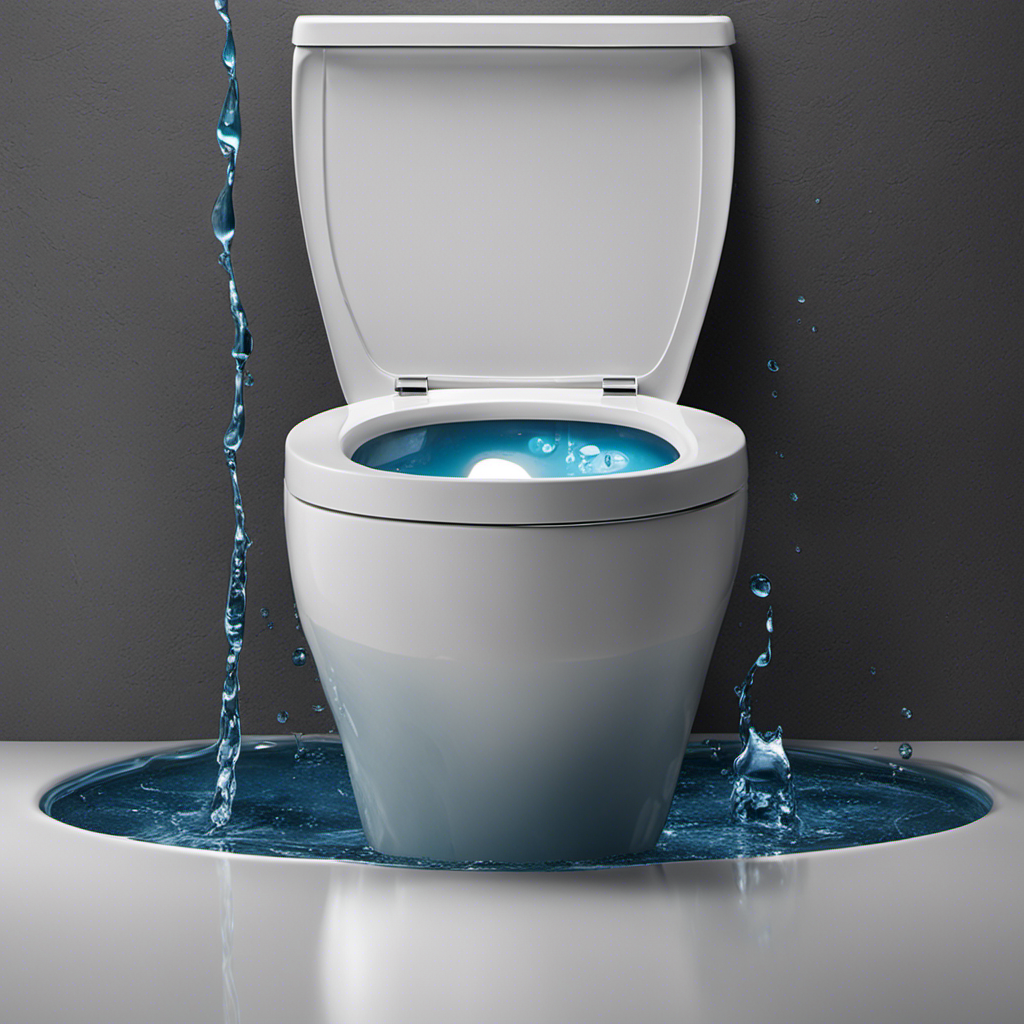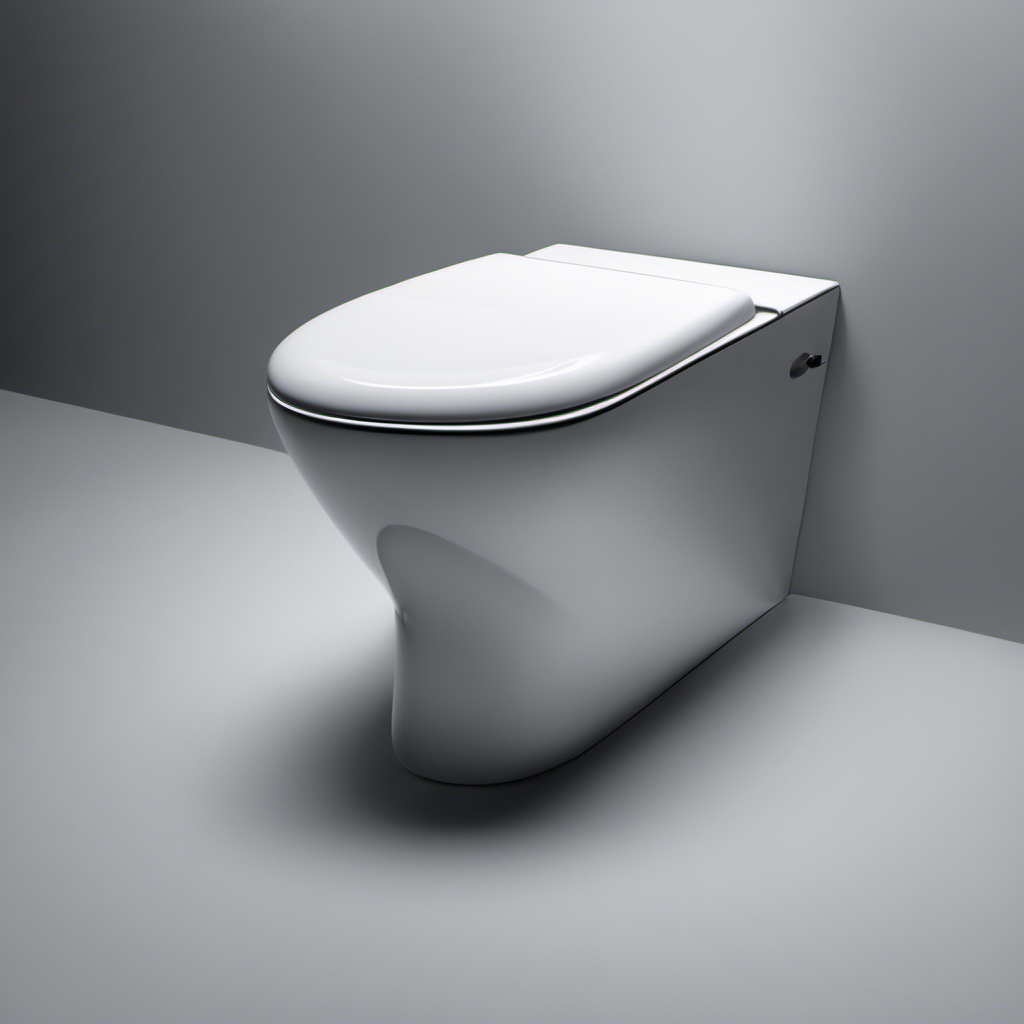I’ve got a leaky toilet on my hands, and let me tell you, it’s not a fun situation to deal with. When I flush, water starts seeping out from the base, causing a mess and wasting precious resources.
But fear not, because I’ve done my research and I’m here to share some expert tips on how to fix this issue. From common causes to step-by-step repair guides, I’ve got you covered.
So let’s roll up our sleeves and get that toilet back in working order!
Key Takeaways
- The most common causes of a toilet leaking from the base when flushed are a worn-out wax ring, loose bolts, a misaligned or damaged flange, and a lack of waterproof sealant.
- Signs and symptoms of a toilet base leak include water pooling around the toilet, a foul odor, a loose or damaged toilet flange, and water damage on the floor.
- DIY solutions for fixing a leaking toilet base include inspecting and replacing the wax ring, tightening bolts, checking the flange for damage, and recaulking around the base.
- To prevent toilet base leaks, it is important to ensure proper securement of the toilet, regularly inspect the base for cracks, tighten loose bolts, clean the base regularly, and use waterproof sealant.
Common Causes of a Leaking Toilet Base
One of the most common causes of a leaking toilet base is a worn-out wax ring. The wax ring is located between the toilet base and the floor drain, creating a watertight seal. Over time, the wax ring can deteriorate, causing water to leak out whenever the toilet is flushed.
Common signs of a leaking toilet base include water pooling around the base, a foul odor, and a loose toilet. To fix this issue, the old wax ring needs to be replaced with a new one. It is recommended to hire a professional plumber for this task, as they have the expertise to ensure a proper seal.
To prevent toilet base leaks, regular maintenance is essential. This includes checking the wax ring for wear and tear, tightening any loose bolts, and avoiding excessive plunging.
Signs and Symptoms of a Toilet Base Leak
As a plumbing professional, I often come across cases where homeowners report water pooling around the base of their toilet. This is a common issue that can have various causes, including a leaking wax ring or a cracked toilet flange.
In addition to water pooling, another common complaint is a foul odor near the toilet. This can indicate a potential issue with the toilet’s seal or ventilation system.
Water Pooling Around Toilet
You need to address the issue of water pooling around your toilet as soon as possible. Water pooling around the toilet can be a sign of a leak or a faulty seal. Here are some possible causes of toilet leaks and tips for fixing them:
- Loose or damaged toilet flange: The flange is the piece that connects the toilet to the floor. If it’s loose or damaged, water can seep out.
- Worn out wax ring: The wax ring creates a watertight seal between the toilet and the floor. If it’s worn out, water can leak through.
- Cracked toilet bowl or tank: A crack in the toilet bowl or tank can cause water to leak out.
- Faulty supply line: If the supply line is loose or damaged, it can cause water to pool around the toilet.
- Improper toilet installation: If the toilet was not installed correctly, it can lead to leaks and water pooling.
By addressing these issues promptly, you can prevent further damage and avoid costly repairs.
Now, let’s move on to the next section about the foul odor near the toilet.
Foul Odor Near Toilet
If you notice a foul odor near your toilet, it could be a sign of a plumbing issue that needs to be addressed.
One possible cause of this odor is a faulty toilet base seal. The toilet base seal is an essential component that creates a watertight seal between the toilet base and the floor.
Over time, this seal can deteriorate or become damaged, allowing sewer gases to escape and cause unpleasant smells.
In order to fix this issue, you may need to consider toilet base seal replacement. This involves removing the toilet, cleaning the area, and installing a new seal.
It is important to ensure that the seal is properly installed to prevent any future leaks or odors.
If you are not confident in your plumbing skills, it is recommended to hire a professional for toilet base installation and seal replacement to ensure a proper and effective repair.
DIY Solutions for Fixing a Leaking Toilet Base
There’s a simple DIY solution for fixing a leaking toilet base. If you’re experiencing a leak from the base of your toilet, don’t panic. By following these toilet base repair techniques, you can troubleshoot and fix the issue yourself.
-
Inspect the wax ring: Check if the wax ring is damaged or worn out. It’s located between the toilet flange and the base of the toilet.
-
Tighten the bolts: Ensure that the bolts securing the toilet to the floor are tight. Use a wrench to tighten them if necessary.
-
Replace the wax ring: If the wax ring is damaged, remove the toilet, replace the wax ring, and reinstall the toilet.
-
Check the toilet flange: Inspect the toilet flange for any cracks or damage. Replace it if needed.
-
Recaulk around the base: Apply a fresh bead of caulk around the base of the toilet to create a watertight seal.
Tools and Materials You’ll Need for Repairing a Leaking Toilet Base
When it comes to repairing a leaking toilet base, having the right tools is essential. I recommend having a few key tools on hand, such as an adjustable wrench, a screwdriver set, and a putty knife. These tools will help you remove the toilet, access the damaged area, and make the necessary repairs.
Additionally, it’s important to use recommended repair materials, such as a wax ring, toilet bolts, and a toilet repair kit. These materials are designed specifically for toilet repairs and will ensure a proper and long-lasting fix.
Essential Repair Tools
You’ll need a wrench to tighten the bolts on the toilet base.
Here are some essential repair tools for fixing a leaking toilet base:
- Toilet repair kits: These kits usually include a flapper, fill valve, and other components needed to fix common toilet problems.
- Plunger: Use a plunger to clear any clogs in the toilet drain.
- Adjustable wrench: This tool is necessary for loosening or tightening bolts and nuts.
- Putty knife: A putty knife helps in removing old wax or caulk from the toilet base.
- Bucket: Have a bucket handy to catch any water that may spill during the repair process.
With these essential plumbing tools, you’ll be well-equipped to tackle the task of repairing a leaking toilet base.
Recommended Repair Materials
Having the right repair materials, such as wax rings and caulk, is crucial for fixing a leaking toilet base. These materials ensure a proper seal between the toilet and the floor, preventing any water leakage. In addition to these essential repair materials, there are other alternative solutions that can be used depending on the severity of the leak.
Here is a table that outlines some recommended repair materials and their uses:
| Repair Material | Purpose |
|---|---|
| Wax Ring | Forms a watertight seal between the toilet and the floor |
| Caulk | Seals any gaps or cracks around the base of the toilet |
| Toilet Wedges | Stabilizes the toilet and prevents rocking |
| Epoxy Putty | Repairs small cracks or holes in the toilet base |
When it comes to repair techniques, it is important to follow the manufacturer’s instructions and guidelines. However, if the leak persists or if the damage is extensive, it is recommended to seek professional assistance.
Step-by-Step Guide to Repairing a Toilet Base Leak
To fix a toilet base leak, start by shutting off the water supply and draining the tank. This is a crucial step to prevent any further water damage. Once the tank is empty, you can begin the repair process.
Here are some toilet base repair techniques to consider:
-
Inspect the wax ring: This is often the culprit behind toilet base leaks. Check for any cracks or gaps in the wax ring and replace it if necessary.
-
Tighten the bolts: Over time, the bolts that secure the toilet to the floor may become loose. Use a wrench to tighten them and ensure a secure fit.
-
Check the flange: The flange is the piece that connects the toilet to the waste pipe. Make sure it is properly aligned and securely fastened.
-
Apply sealant: Use a waterproof sealant around the base of the toilet to create a tight seal and prevent any future leaks.
-
Test for leaks: Once the repairs are complete, turn on the water supply and flush the toilet to check for any remaining leaks.
When to Call a Professional Plumber for a Leaking Toilet Base
If you’re uncertain about repairing a leaky toilet base, it’s always a good idea to contact a professional plumber for assistance. While some minor leaks can be fixed with simple repairs, there are certain signs that indicate it may be time to replace your toilet or that there may be hidden leaks causing the problem. Here are a few signs to look out for:
| Signs of Hidden Leaks | When to Replace Toilet |
|---|---|
| Constantly running water | Frequent repairs |
| Mold or mildew growth | Cracks in the porcelain |
| Water damage on the floor | Age of the toilet |
If you notice any of these signs, it’s best to consult a plumber. They will be able to assess the situation and determine the best course of action, whether it’s repairing the leak or replacing the toilet altogether. Remember, it’s always better to be safe than sorry when it comes to plumbing issues.
Preventive Maintenance Tips to Avoid Toilet Base Leaks
Regularly checking for signs of water damage and promptly addressing any issues can help prevent toilet base leaks. Maintaining the toilet base is crucial to avoid potential leaks and water damage.
Here are some preventive maintenance tips to keep your toilet base in good condition:
- Ensure that the toilet is properly secured to the floor.
- Regularly inspect the base for any cracks or chips.
- Tighten any loose bolts or nuts connecting the toilet to the floor.
- Clean the base regularly to prevent the buildup of dirt, grime, and mold.
- Use a waterproof sealant around the base to create a barrier against water leaks.
By following these preventive maintenance tips, you can minimize the risk of toilet base leaks and protect your bathroom from water damage.
Conclusion
Well, it turns out that a leaking toilet base is no small matter. In fact, it’s like a mini indoor swimming pool in your bathroom! But fear not, my friends, for there is hope.
Armed with the right tools and a little know-how, you can tackle this plumbing predicament head-on. From identifying the common causes to providing step-by-step solutions, this article has got you covered.
So, don’t let that leaky base get you down. Take charge, fix it up, and bid farewell to bathroom floods forever!










